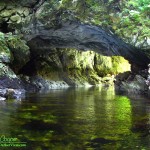The usual archeological work done in SE Alaska documents the tribes of the region. Tribes such as the Tlingit, Haida, Tsimshian, and Eyak, the people that still make their homes along the coast and in these islands. But there is a much older tale to be found here, evidence of the first men to reach these lands, and sites that date back more than 10,000 years.

Many of the SE Alaskan islands feature limestone geology, allowing the formation of caves, photo by Andrew Cooper
What many people do not realize, is that the islands of SE Alaska may have been stepping stones for the first humans to arrive in the Americas. Following the coastline, making use of the rich marine food sources. As the ice retreated, these islands may have been the first open path into the vast, unpopulated lands of North and South America.
Looking for signs of these first settlers is a top priority for archeologists. Unfortunately many of those early settlements and campsites are now underwater. As the ice sheets melted, sea levels rose. Those early men would not have been all that different from today’s Alaskans, creating camps along the water, in sheltered coves and bays. Most of these sites are now submerged. But in SE Alaska there was also uplift of geologic formations. Finding sites in the uplifted formations could yield invaluable information on the first Americans.
Such sites have already been found and preserved in the caves of northern Prince of Wales Island. Here a limestone geology has allowed the formation of hundreds of caves. Many have been explored and are being studied to understand groundwater movement and for archeological purposes. Quite a few caves have been used by animals; bears, foxes, otters and rodents. The litter of bones and debris left by these residents have also proven quite valuable to biologists, yielding a record of regional wildlife reaching back up to 50,000 years, well into the ice ages.
A few rare caves have produced something else, human bones and tools over 10,000 years old. The best of these finds was a cave found by loggers, appropriately named On Your Knees Cave. Over the course of seven years, teams have painstakingly excavated the entire cave, in the process collecting thousands of bones. Most of what was found in the cave represents the litter left by bears or otters. Among the other residents debris, a few precious human bones and tools were discovered. Genetic analysis of these bones show common genetic traits with the modern tribes of North America.
There is a great website that details the excavations of On Your Knees Cave, as well as many other caves found in the region. Read on to learn about the story of discovery, of very early archeology in SE Alaska. These finds show that humans had reached and used these islands over 10,000 years ago. The search is on for sites that could be over 14,000 years old, the ancestors of all modern North American tribes.
